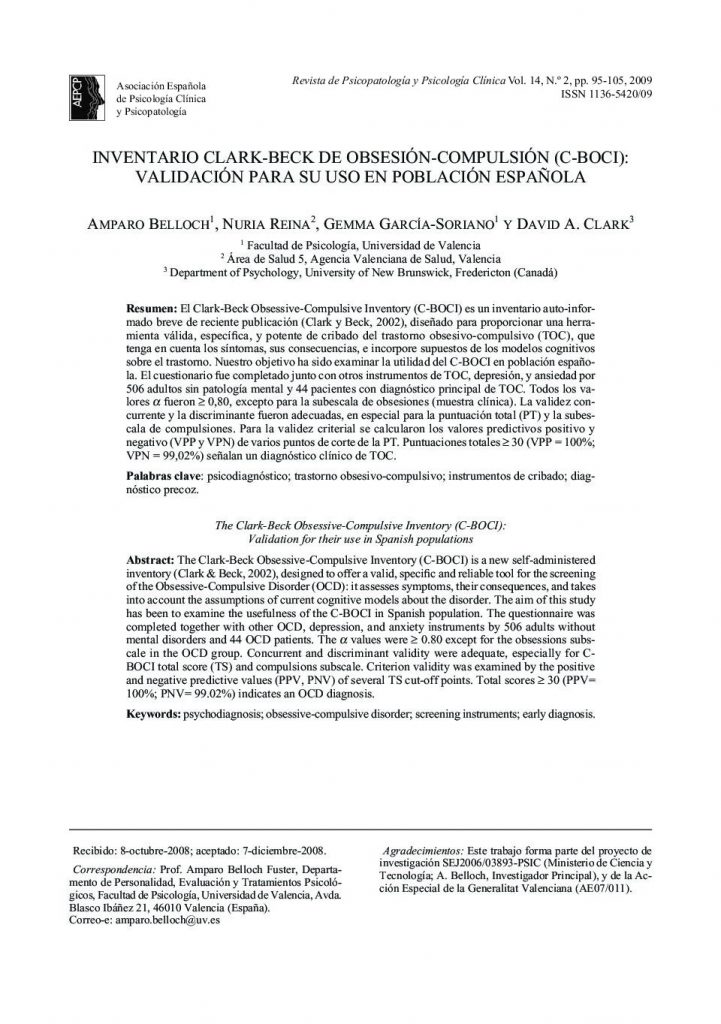Inventario Clark-Beck de Obsesión-Compulsión (C-BOCI): Validación para su uso en población española.

- Estilos parentales percibidos, psicopatología y personalidad en la adolescencia.
- Tratamiento cognitivo-conductual grupal del trastorno de pánico con o sin agorafobia en un centro de salud mental público.
- Inventario Clark-Beck de Obsesión-Compulsión (C-BOCI): Validación para su uso en población española.
- Validación española del cuestionario de preocupación pswq: Estructura factorial y propiedades psicométricas.
- Validez factorial de la estructura del Cuestionario Breve de Burnout (cbb) en una muestra de docentes en Aragón.
- Errata en: “Las reacciones postraumáticas en infancia y adolescencia maltratada: El trauma complejo”.
The Clark-Beck Obsessive-Compulsive Inventory (C-BOCI) is a recent self-administered inventory (Clark y Beck, 2002), designed to offer a valid, specific and reliable tool for the screening of Obsessive-Compulsive Disorder (OCD): it assesses symptoms and their consequences, and takes into account the assumptions of current cognitive models about the disorder. The aim of this study has been to examine the usefulness of the C-BOCI in a Spanish population. The questionnaire was completed together with other OCD, depression, and anxiety instruments by 506 adults without mental disorders and 44 OCD patients. The α values were ≥0.80 except for the obsessions subscale in the clinical sample. Concurrent and discriminant validity were adequate, especially for the total score (TS) and the compulsions subscale. Criterion validity was calculated by the positive and negative predictive values (PPV, PNV) of several TS cut-off points. Total scores ≥ 30 (PPV= 100%; PNV= 99.02%) indicate a clinical OCD diagnosis.
El Clark-Beck Obsessive-Compulsive Inventory (C-BOCI) es un inventario auto-informado breve de reciente publicación (Clark y Beck, 2002), diseñado para proporcionar una herramienta válida, específica, y potente de cribado del trastorno obsesivo-compulsivo (TOC), que tenga en cuenta los síntomas, sus consecuencias, e incorpore supuestos de los modelos cognitivos sobre el trastorno. Nuestro objetivo ha sido examinar la utilidad del C-BOCI en población española. El cuestionario fue completado junto con otros instrumentos de TOC, depresión, y ansiedad por 506 adultos sin patología mental y 44 pacientes con diagnóstico principal de TOC. Todos los valores α fueron ≥ 0,80, excepto para la subescala de obsesiones (muestra clínica). La validez concurrente y la discriminante fueron adecuadas, en especial para la puntuación total (PT) y la subescala de compulsiones. Para la validez criterial se calcularon los valores predictivos positivo y negativo (VPP y VPN) de varios puntos de corte de la PT. Puntuaciones totales ≥ 30 (VPP = 100%; VPN = 99,02%) señalan un diagnóstico clínico de TOC.



